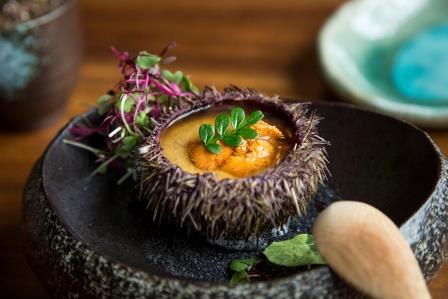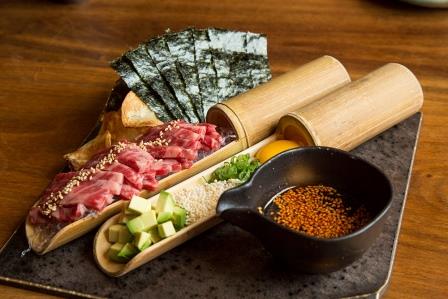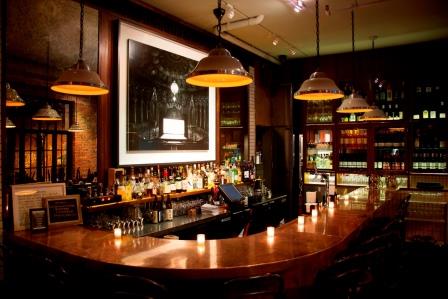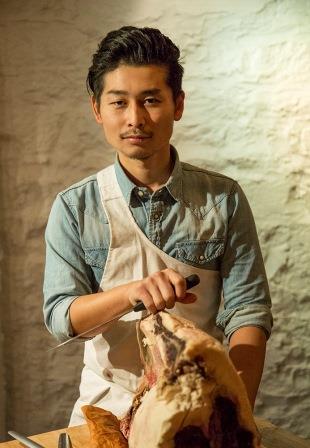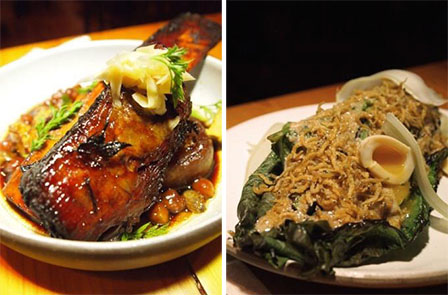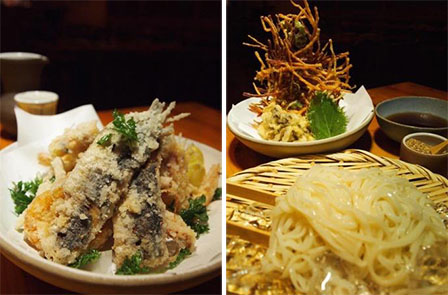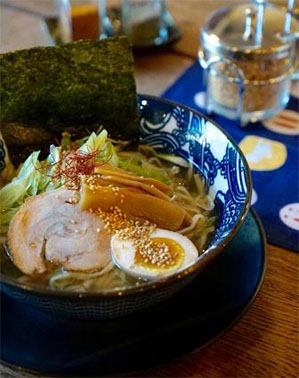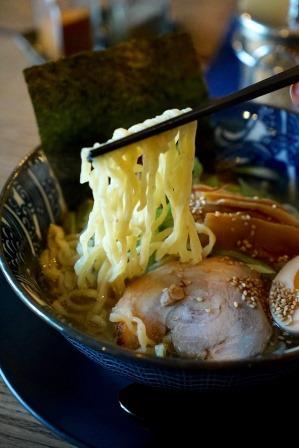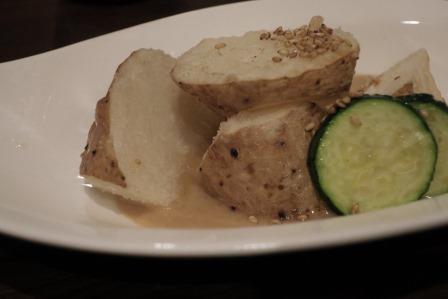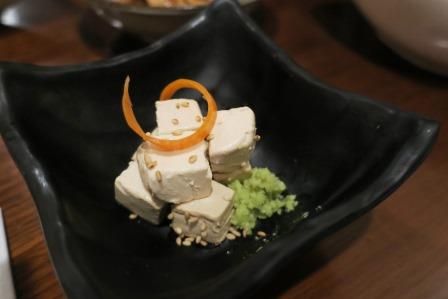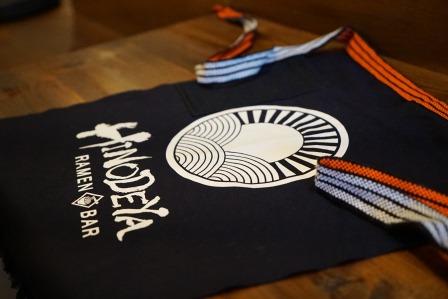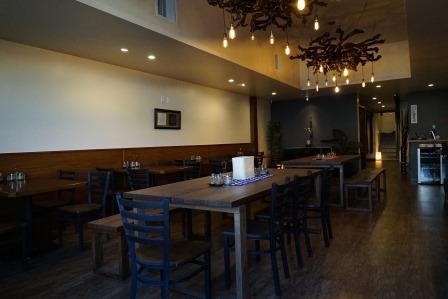Take note on American beef steak created by high-quality dry aging technique of Japan
By Aya Ota
In the Williamsburg district of Brooklyn, stylish and innovative stores are appearing one after another, and you find something new every time you visit. People think that this town is most sensitive about the newest trends. In such a town, extremely stylish exteriors draw your attention. Once you step inside, a sophisticatedly designed interior space opens in front of you. It is “Salt + Charcoal” restaurant. Until recently, this place had been running as a popular robata-yaki izakaya restaurant mostly for local customers, but in March of this year, the menu was completely renewed to kick off a new concept, “Japanese Style Steak House + Brasserie”, and is gaining a lot of attention.
“Salt and charcoal are the basics of cooking,” says the owner, Teruyuki Takayama to explain how the name of the restaurant came about. He has a unique background as a producer/CEO of a film production company. When he became 40 years old, he felt like challenging himself to a completely different field, and started a restaurant business. It took him 2 years to open the restaurant as he struggled through issues including finding real estate, undergoing various building construction problems, experiencing difficulty in obtaining the license to use charcoal, etc. Then, 2 years after the opening, he decided to renew the menu with the change of the chef to make a new start. The concept of cooking with charcoal stayed the same, but the robata grill using Bincho charcoal was removed, and instead he installed a customized charcoal specialized grill with which they offer dynamic dishes of meat and seafood.
The menu renewal was especially focused on the steak section. The new Executive chef, Tadaaki Ishizaki, is a meat expert. Not only had he been displaying his expert skills in a steak house in Japan, but he also has a long career in the sites of meat production, processing, and sales. He has the title of “Japan Dry Aging Beef Promotion Board Certified Cook”. He says, “Compared to America and Europe, Japan has a shorter history of dry aging. However, after studying enthusiastically, Japan now holds a very high standard technique which, I can probably say, has progressed and become No. 1 in the world”. Mr. Ishizaki continues representing his passion - “I would like to serve the best meat dishes by appropriately using high-quality American beef and wagyu beef with the reimported high standard technique cultivated in Japan.”
He is very particular about selecting the meat he uses. He goes to the contracted meat seller to select fresh meat by himself. He then insists on having the meat age for a month. “Porterhouse Steak using such dry aged beef is his proud menu item. The menu has a wide variety of dishes. Other steak menu items include Kumamoto wagyu, T-Bone, NY strip, etc. Besides beef, there is also duck, lamb, salmon, branzino, octopus, lobster, etc. Each ingredient is grilled in the most appropriate way, and served with the best matched sauce. You can also order extra house sauces ($1.50 to $2 each) to differentiate the taste. There are more than 15 different kinds, which makes you feel like trying them all. The unique sauces accentuated by Japanese spices include “Balsamic butter soy sauce”, “Miso garlic butter, “Green onion ponzu chili oil”, “Sansai (mountain vegetables) mayonnaise”, etc.
Other sections of the menu such as appetizers, raw bar, sushi (rice), salad, etc. also contain dishes full of imagination. It would not be easy to skip to the steak menu. “Uni Truffle Pudding” ($16) is a sumptuous item using one whole sea urchin combined with truffle oil, truffle salt, and truffle foam. “Whole Shrimp Croquette” ($21) is a unique dish deep-fried using Kadaif as the coating. The custom-made tartar sauce goes perfectly well with it. “Wagyu “Yukke” Tartare” ($26) is delivered to the table in a bamboo container, and then, your server mixes the ingredients in front of you. Its spicy taste eaten with dried seaweed or potato chips makes you want to drink more sake. Chef Ishizaki has worked for “Joel Robuchon”, a top-notch French restaurant. The elegant and gorgeous presentation he creates, using full knowledge and technique of French cuisine, takes your breath away.
The majority of the customers are locals, and 95% of them are non-Japanese. The renewal of the menu was targeted to invite many new customers by accommodating the local needs. On the other hand, due to the price increase, there is a risk of losing the regulars who have been enjoying the old casual robata-yaki izakaya style. The former popular menu items such as karaage and yakitori are gone from the dinner menu.
Despite of the risk, I can also smell success. I cannot take my eyes off of the new start and the future development of “Salt + Charcoal”.
日本の高いドライエイジング技術と米国産牛肉で生まれるステーキに注目
おしゃれで斬新な店舗が次々と登場し、訪れる度に新しい発見があるブルックリンのウィリアムズバーグ地区。今、ニューヨークで最も流行感度が高いと言われるこの街で、ひときわスタイリッシュな外観に目を奪われ足を踏み入れると、洗練されたデザインの空間が広がる――ここ『Salt + Charcoal』は、これまで炉端焼き居酒屋として、地元客を中心に定着してきたが、この3月からメニューを一新、「Japanese Style Steak House+Brasserie」という全く新しいコンセプトを打ち出して、注目されている。
「塩と炭は料理の原点」と店名の由来を語るのは、同店のオーナー、高山輝之氏。映像制作会社を経営するプロデューサーという異色の経歴の持ち主だ。40歳になったときに、これまでとは全く違う分野に挑戦したいと思い立ち、新しくレストランビジネスに取り組んだ。不動産探しに始まり、さまざまな工事や炭使用ライセンス取得など、次々と難題を解決しながら、約2年の歳月をかけて開店にこぎ着けた。そして、開店からまた2年経った今、シェフが変わるのを機にメニューを一新、再出発することになった。炭火というコンセプトは一貫しているが、備長炭を使った炉端は撤廃、特注の炭火専用グリルを導入し、肉類や魚介類をダイナミックに提供する。
今回のメニュー改変で特に力を入れているのはステーキ。新しく料理長として就任した石崎忠烈氏は、肉に精通したシェフだ。日本のステーキハウスで腕を奮ってきただけでなく、生産・加工・販売の現場でも経験を積んできた。日本ドライエイジングビーフ普及協会・認定調理委員という肩書きも持ち、「日本では、欧米と比較してドライエイジングの歴史は浅いが、熱心な研究が進んだ結果、世界一と言っても過言ではない高い技術を培っている」と語る。「日本で培った高い技術を米国に逆輸入し、米国産の高品質な牛肉や和牛を使い分け、最高の肉料理を提供したい」と意気込みを見せる。シェフ自ら指定業者に足を運び、自分の目で鮮肉を選び、1カ月かけて熟成してもらっているというこだわりよう。そのドライエイジングビーフを使ったポーターハウス・ステーキは彼の自信作だ。熊本産和牛やティーボーン、ニューヨーク・ストリップなど各種ステーキを用意。牛肉以外では、鴨、ラム、サーモンブランジーノ、タコ、ロブスターなど豊富に取りそろえ、素材に応じた最も適切な方法でグリルする。それぞれ、最も相性のよいソースを添えて提供されるが、店オリジナルのソース(1.5~2ドル)を追加注文して、味に変化をつけることもできる。「バルサミコバター醤油」「味噌ガーリックバター」「ネギポン酢ラー油」「山葵マヨネーズ」など、和風スパイスをアクセントにした個性的なソースが15種類以上もあり、次々と試したくなる。
前菜やローバー、寿司(ライス)、サラダなどのセクションも、創意工夫に富んだ料理が並んでおり、うっかりステーキにたどり着けないのではないかと思うほどの充実ぶりだ。「ウニ、トリュフプディング」(16ドル)はウニを丸々1個分使い、トリュフ油・トリュフ塩・トリュフ泡を組み合わせた贅沢な一品。「海老のクリームコロッケ 」(21ドル)は、カダイフを衣に使い揚げたユニークな一品。特性タルタルソースとの相性が抜群だ。「和牛タルタル」(26ドル)は、具材が竹製容器に盛り付けられてテーブルに運ばれた後、サーバーが目の前で混ぜてくれる。海苔や店特製ポテトチップスに載せて食べると、思わず酒が進んでしまうスパイシーな味付けだ。石崎シェフは一流フランス料理店『ジョエル・ロブション』でも勤務した経験がある。フレンチの技術や知識も存分に活かした、優雅で華やかなプレゼンテーションにも目を奪われる。
同店の客層は地元客が中心で、95%が非日本人だ。今回のメニュー改変で、地元ニーズにより合致する内容となり、多くの新規客を取り込むことを狙っている。一方で、価格も上がるため、これまでカジュアルな炉端焼き居酒屋を楽しんでいた常連客を失うリスクもあるかもしれない。人気メニューだった唐揚げや焼き鳥も、ディナータイムでは封印する。
リスクは伴うがすでに成功の予感がする『Salt + Charcoal』の再出発――今後の展開から目が離せない。
Salt + Charcoal
171 Grand Street
Brooklyn, NY 11249
Tel: 718-782-2087
http://www.saltandcharcoal.com/
In the Williamsburg district of Brooklyn, stylish and innovative stores are appearing one after another, and you find something new every time you visit. People think that this town is most sensitive about the newest trends. In such a town, extremely stylish exteriors draw your attention. Once you step inside, a sophisticatedly designed interior space opens in front of you. It is “Salt + Charcoal” restaurant. Until recently, this place had been running as a popular robata-yaki izakaya restaurant mostly for local customers, but in March of this year, the menu was completely renewed to kick off a new concept, “Japanese Style Steak House + Brasserie”, and is gaining a lot of attention.
“Salt and charcoal are the basics of cooking,” says the owner, Teruyuki Takayama to explain how the name of the restaurant came about. He has a unique background as a producer/CEO of a film production company. When he became 40 years old, he felt like challenging himself to a completely different field, and started a restaurant business. It took him 2 years to open the restaurant as he struggled through issues including finding real estate, undergoing various building construction problems, experiencing difficulty in obtaining the license to use charcoal, etc. Then, 2 years after the opening, he decided to renew the menu with the change of the chef to make a new start. The concept of cooking with charcoal stayed the same, but the robata grill using Bincho charcoal was removed, and instead he installed a customized charcoal specialized grill with which they offer dynamic dishes of meat and seafood.
The menu renewal was especially focused on the steak section. The new Executive chef, Tadaaki Ishizaki, is a meat expert. Not only had he been displaying his expert skills in a steak house in Japan, but he also has a long career in the sites of meat production, processing, and sales. He has the title of “Japan Dry Aging Beef Promotion Board Certified Cook”. He says, “Compared to America and Europe, Japan has a shorter history of dry aging. However, after studying enthusiastically, Japan now holds a very high standard technique which, I can probably say, has progressed and become No. 1 in the world”. Mr. Ishizaki continues representing his passion - “I would like to serve the best meat dishes by appropriately using high-quality American beef and wagyu beef with the reimported high standard technique cultivated in Japan.”
He is very particular about selecting the meat he uses. He goes to the contracted meat seller to select fresh meat by himself. He then insists on having the meat age for a month. “Porterhouse Steak using such dry aged beef is his proud menu item. The menu has a wide variety of dishes. Other steak menu items include Kumamoto wagyu, T-Bone, NY strip, etc. Besides beef, there is also duck, lamb, salmon, branzino, octopus, lobster, etc. Each ingredient is grilled in the most appropriate way, and served with the best matched sauce. You can also order extra house sauces ($1.50 to $2 each) to differentiate the taste. There are more than 15 different kinds, which makes you feel like trying them all. The unique sauces accentuated by Japanese spices include “Balsamic butter soy sauce”, “Miso garlic butter, “Green onion ponzu chili oil”, “Sansai (mountain vegetables) mayonnaise”, etc.
Other sections of the menu such as appetizers, raw bar, sushi (rice), salad, etc. also contain dishes full of imagination. It would not be easy to skip to the steak menu. “Uni Truffle Pudding” ($16) is a sumptuous item using one whole sea urchin combined with truffle oil, truffle salt, and truffle foam. “Whole Shrimp Croquette” ($21) is a unique dish deep-fried using Kadaif as the coating. The custom-made tartar sauce goes perfectly well with it. “Wagyu “Yukke” Tartare” ($26) is delivered to the table in a bamboo container, and then, your server mixes the ingredients in front of you. Its spicy taste eaten with dried seaweed or potato chips makes you want to drink more sake. Chef Ishizaki has worked for “Joel Robuchon”, a top-notch French restaurant. The elegant and gorgeous presentation he creates, using full knowledge and technique of French cuisine, takes your breath away.
The majority of the customers are locals, and 95% of them are non-Japanese. The renewal of the menu was targeted to invite many new customers by accommodating the local needs. On the other hand, due to the price increase, there is a risk of losing the regulars who have been enjoying the old casual robata-yaki izakaya style. The former popular menu items such as karaage and yakitori are gone from the dinner menu.
Despite of the risk, I can also smell success. I cannot take my eyes off of the new start and the future development of “Salt + Charcoal”.
日本の高いドライエイジング技術と米国産牛肉で生まれるステーキに注目
おしゃれで斬新な店舗が次々と登場し、訪れる度に新しい発見があるブルックリンのウィリアムズバーグ地区。今、ニューヨークで最も流行感度が高いと言われるこの街で、ひときわスタイリッシュな外観に目を奪われ足を踏み入れると、洗練されたデザインの空間が広がる――ここ『Salt + Charcoal』は、これまで炉端焼き居酒屋として、地元客を中心に定着してきたが、この3月からメニューを一新、「Japanese Style Steak House+Brasserie」という全く新しいコンセプトを打ち出して、注目されている。
「塩と炭は料理の原点」と店名の由来を語るのは、同店のオーナー、高山輝之氏。映像制作会社を経営するプロデューサーという異色の経歴の持ち主だ。40歳になったときに、これまでとは全く違う分野に挑戦したいと思い立ち、新しくレストランビジネスに取り組んだ。不動産探しに始まり、さまざまな工事や炭使用ライセンス取得など、次々と難題を解決しながら、約2年の歳月をかけて開店にこぎ着けた。そして、開店からまた2年経った今、シェフが変わるのを機にメニューを一新、再出発することになった。炭火というコンセプトは一貫しているが、備長炭を使った炉端は撤廃、特注の炭火専用グリルを導入し、肉類や魚介類をダイナミックに提供する。
今回のメニュー改変で特に力を入れているのはステーキ。新しく料理長として就任した石崎忠烈氏は、肉に精通したシェフだ。日本のステーキハウスで腕を奮ってきただけでなく、生産・加工・販売の現場でも経験を積んできた。日本ドライエイジングビーフ普及協会・認定調理委員という肩書きも持ち、「日本では、欧米と比較してドライエイジングの歴史は浅いが、熱心な研究が進んだ結果、世界一と言っても過言ではない高い技術を培っている」と語る。「日本で培った高い技術を米国に逆輸入し、米国産の高品質な牛肉や和牛を使い分け、最高の肉料理を提供したい」と意気込みを見せる。シェフ自ら指定業者に足を運び、自分の目で鮮肉を選び、1カ月かけて熟成してもらっているというこだわりよう。そのドライエイジングビーフを使ったポーターハウス・ステーキは彼の自信作だ。熊本産和牛やティーボーン、ニューヨーク・ストリップなど各種ステーキを用意。牛肉以外では、鴨、ラム、サーモンブランジーノ、タコ、ロブスターなど豊富に取りそろえ、素材に応じた最も適切な方法でグリルする。それぞれ、最も相性のよいソースを添えて提供されるが、店オリジナルのソース(1.5~2ドル)を追加注文して、味に変化をつけることもできる。「バルサミコバター醤油」「味噌ガーリックバター」「ネギポン酢ラー油」「山葵マヨネーズ」など、和風スパイスをアクセントにした個性的なソースが15種類以上もあり、次々と試したくなる。
前菜やローバー、寿司(ライス)、サラダなどのセクションも、創意工夫に富んだ料理が並んでおり、うっかりステーキにたどり着けないのではないかと思うほどの充実ぶりだ。「ウニ、トリュフプディング」(16ドル)はウニを丸々1個分使い、トリュフ油・トリュフ塩・トリュフ泡を組み合わせた贅沢な一品。「海老のクリームコロッケ 」(21ドル)は、カダイフを衣に使い揚げたユニークな一品。特性タルタルソースとの相性が抜群だ。「和牛タルタル」(26ドル)は、具材が竹製容器に盛り付けられてテーブルに運ばれた後、サーバーが目の前で混ぜてくれる。海苔や店特製ポテトチップスに載せて食べると、思わず酒が進んでしまうスパイシーな味付けだ。石崎シェフは一流フランス料理店『ジョエル・ロブション』でも勤務した経験がある。フレンチの技術や知識も存分に活かした、優雅で華やかなプレゼンテーションにも目を奪われる。
同店の客層は地元客が中心で、95%が非日本人だ。今回のメニュー改変で、地元ニーズにより合致する内容となり、多くの新規客を取り込むことを狙っている。一方で、価格も上がるため、これまでカジュアルな炉端焼き居酒屋を楽しんでいた常連客を失うリスクもあるかもしれない。人気メニューだった唐揚げや焼き鳥も、ディナータイムでは封印する。
リスクは伴うがすでに成功の予感がする『Salt + Charcoal』の再出発――今後の展開から目が離せない。
Salt + Charcoal
171 Grand Street
Brooklyn, NY 11249
Tel: 718-782-2087
http://www.saltandcharcoal.com/








